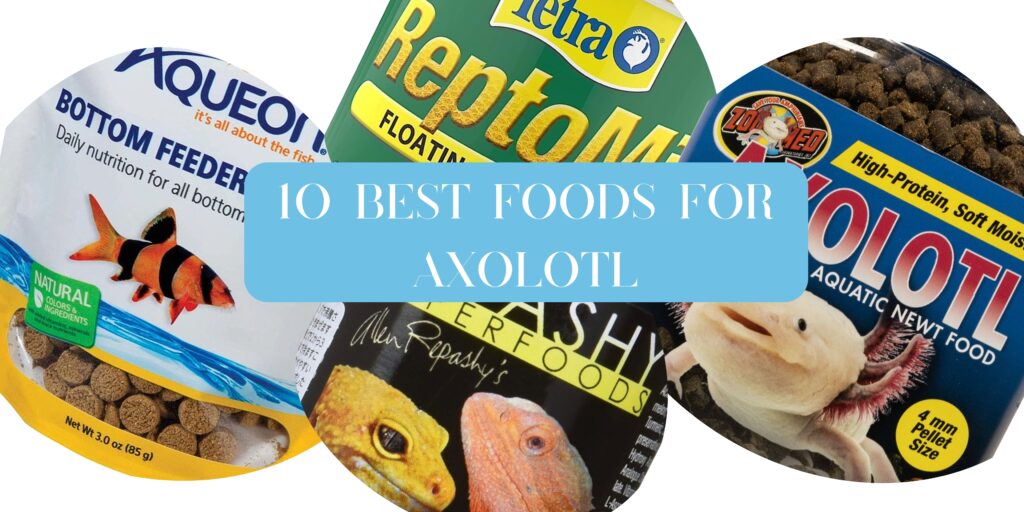
In 2023, providing the optimal diet for your axolotl is essential for their well-being and vitality. The market offers a diverse range of foods specifically formulated to meet the unique nutritional needs of these aquatic wonders. Whether you’re a seasoned axolotl enthusiast or a newcomer to the amphibian care scene, understanding the top food choices is crucial. In this guide, we present the 10 best foods for axolotl in 2023, carefully curated to ensure a balanced and nourishing diet that promotes growth, health, and the overall thriving of these fascinating aquatic creatures. From high-quality pellets to frozen treats and specialized gel foods, this selection encompasses a variety of options, each with its own set of benefits tailored to meet the dietary requirements of axolotls at different life stages. Explore this comprehensive guide to make informed choices and elevate the feeding routine of your cherished axolotl companions.
1. Hikari Massivore Delite
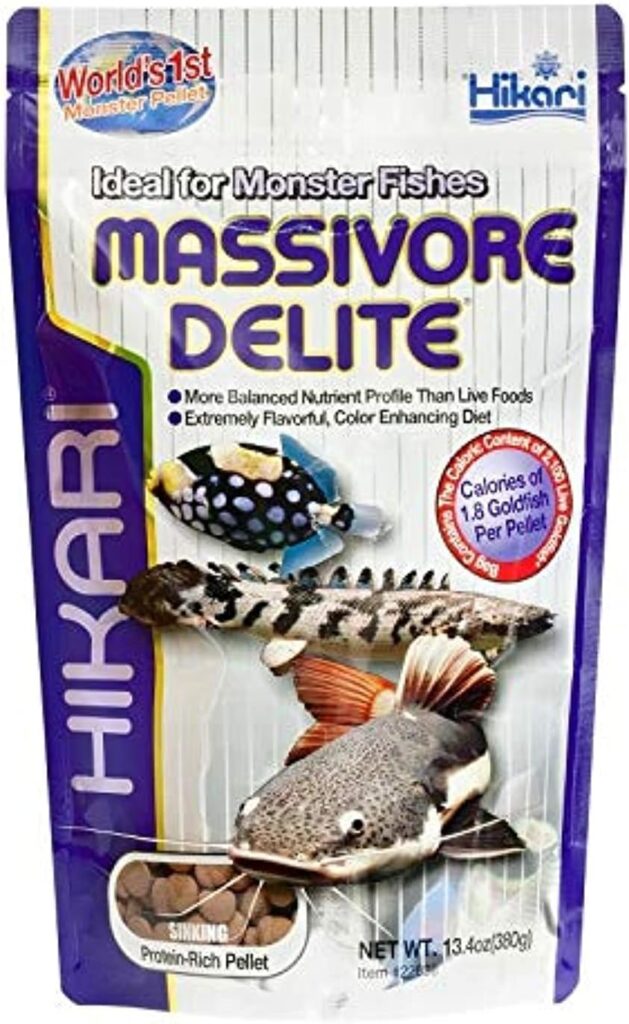
Features
- Brand: Hikari
- Flavor: Fish
- Age Range: All Life Stages
- Item Form: Pellet, Stick, Frozen
- Specific Uses: Fish Food
- Ingredients: Fish Meal, Krill Meal, Starch, Fish Oil, Wheat Flour, Dried Seaweed Meal, Spirulina, Brewers Dried Yeast, Dried A. Niger Fermentation Extract, Astaxanthin, Canthaxanthin, Vitamins And Minerals
Pros
- Suitable for all life stages of axolotls.
- Diverse ingredient list for nutritional balance.
- Available in different forms (pellet, stick, frozen) for feeding variety.
- Well-established brand with positive customer reviews.
- No indication of discontinuation.
Cons
- No major cons reported based on available information.
Hikari Massivore Delite stands out as a premium choice for axolotl nutrition. Developed by the reputable brand Hikari, this fish food is tailored for all life stages, offering a versatile diet in pellet, stick, and frozen forms. The ingredient list boasts fish meal, krill meal, and essential vitamins, ensuring a balanced and nutritious meal. With a favorable customer rating of 4.7 out of 5 stars, it has gained trust for its effectiveness. Users appreciate its versatility and the absence of any reported cons.
2. Omega One Axolotl Pellets
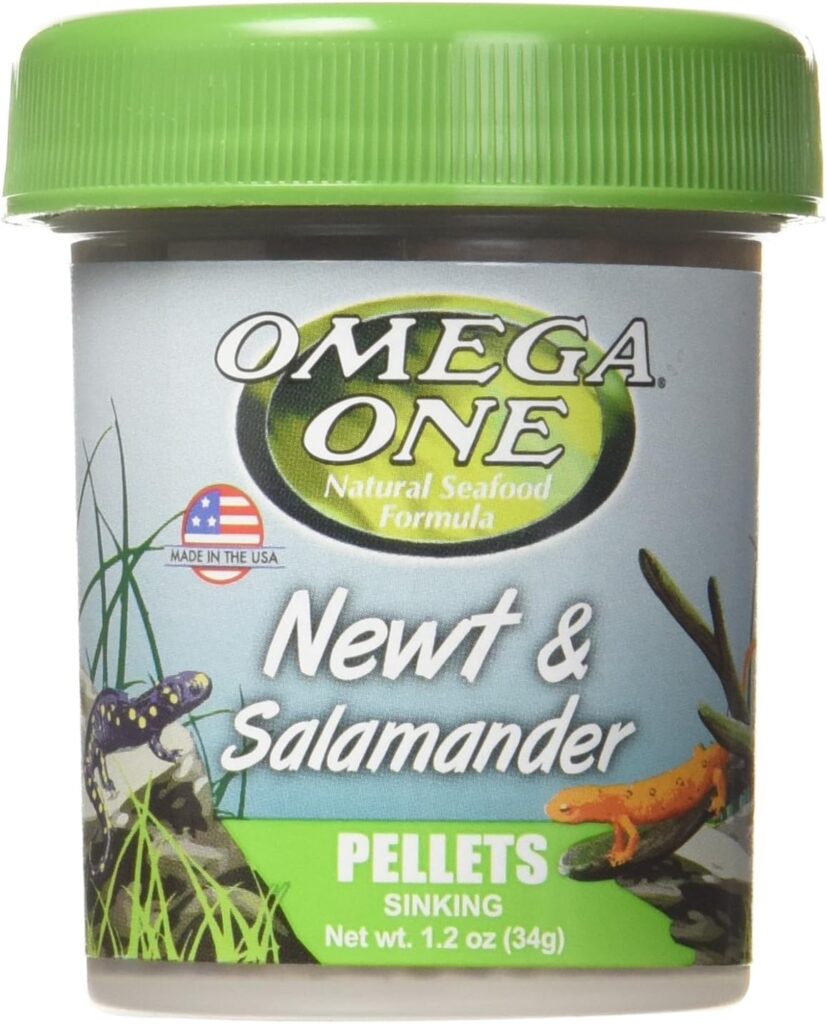
Features
- Brand: Omega One
- Rating: 4.3 out of 5 stars (139 ratings)
- Ingredients: Salmon, Whole Herring, Wheat Flour, Wheat Germ, Pea Protein, Whole Shrimp, Wheat Gluten, Kelp, Astaxanthin, Canthaxanthin, Potassium Sorbate, Tocopherol, Annatto Extract, Lecithin, Calcium L-Ascorbyl-2-Monophosphate, etc.
- Less starch for cleaner water.
- Formulated with essential vitamins and minerals.
Pros
- High lipid, low fiber pellets for axolotl growth.
- Essential vitamins and minerals for healthy development.
- Reduced starch for less waste.
- Positive customer reviews.
Cons
- Potentially designed for use in the US, requiring adapters for international users.
Omega One Axolotl Pellets, rated at 4.3 out of 5 stars, is recognized for its high lipid and low fiber composition, promoting amphibian growth. Enriched with vital vitamins like A and D3, and calcium, this pellet is designed for optimal axolotl health. Although currently unavailable, it garners positive reviews for its nutritional value and reduced starch content, translating to cleaner water. However, potential international users should consider the product’s US-centric design.
3. San Francisco Bay Brand Frozen Bloodworms
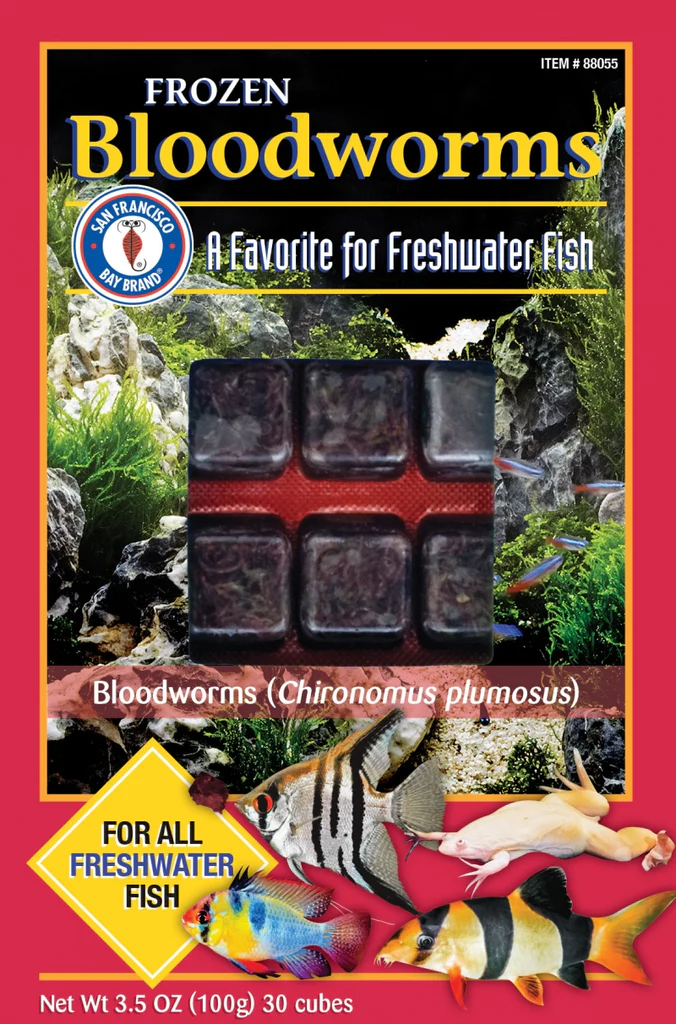
Features
- Regular Price: $5.39
- Available Sizes: 3.5 oz cubes
- Crude Protein: 3.5%, Crude Fat: 0.3%, Crude Fiber: 0.7%, Moisture: 94.5%, Ash: 0.8%, Phosphorus: 0.1%
- Suitable for discus, eels, bettas, loaches, and other freshwater fish.
Pros
- Daily collection and packaging for freshness.
- Essential nutrients for high energy levels.
- Available in different forms (cubes, flats, cubes on a roll).
- Reasonably priced.
- Additional related products for varied feeding.
Cons
- No significant cons reported
San Francisco Bay Frozen Bloodworms provide a natural, nutrient-rich food source for axolotls and other freshwater fish. The daily collection and packaging of bloodworms ensure freshness, and the guaranteed analysis displays a well-balanced nutritional profile. With a reasonable price point and availability in various forms, including cubes and flats, it offers flexibility to fish owners. The absence of significant reported cons adds to its appeal, making it a favored choice for enhancing energy levels and vigor in freshwater fish.
4. Repashy Grub Pie Gel Food

Features
- Brand: Repashy
- Flavor: Reptile
- Item Form: Jar
- Guaranteed Analysis: Crude Protein 40%, Crude Fat 12%, Crude Fiber 15%, Moisture 10%, Ash 12%, Calcium 1.4%
- Directions for preparation and feeding.
Pros
- Insect-based meal replacement.
- Suitable for insectivores and omnivores.
- Positive customer ratings.
- Versatile preparation options.
Cons
- Not for human consumption.
Repashy Grub Pie Gel Food is a unique insect-based meal replacement suitable for both insectivores and omnivores. With a high protein content and positive customer ratings (4.4 out of 5 stars), it serves as a staple or treat. The easy preparation process and versatile feeding options make it a convenient choice. Currently unavailable, its future availability is uncertain, but its positive customer feedback emphasizes its effectiveness.
5. Hikari Frozen Bloodworms
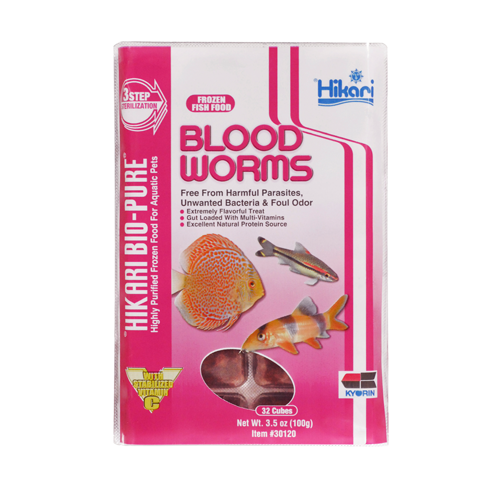
Features
- Description: Higher protein natural food for tropical and select marine fishes.
- Available Size: 3.5 oz cubes
- Benefits: Naturally contain fatty acids, color enhancement, easy-to-use mini cubes.
Pros
- High protein content.
- Fatty acids and color-enhancing nutrients.
- Sterilized for safety.
- Positive manufacturing processes.
- Easy-to-use mini cubes.
Cons
- No major cons reported
Hikari Frozen Bloodworms offer a higher protein, natural treat for tropical and marine fishes. The proprietary processes, including sterilization and a multi-step cleansing process, ensure safety and cleanliness. The “no touch™” mini cubes simplify measured feeding, and the inclusion of essential nutrients enhances its nutritional value. Positive manufacturing practices and customer reviews make it a reliable choice for fish owners seeking a nutritious treat.
6. Tetra ReptoMin Floating Food Sticks
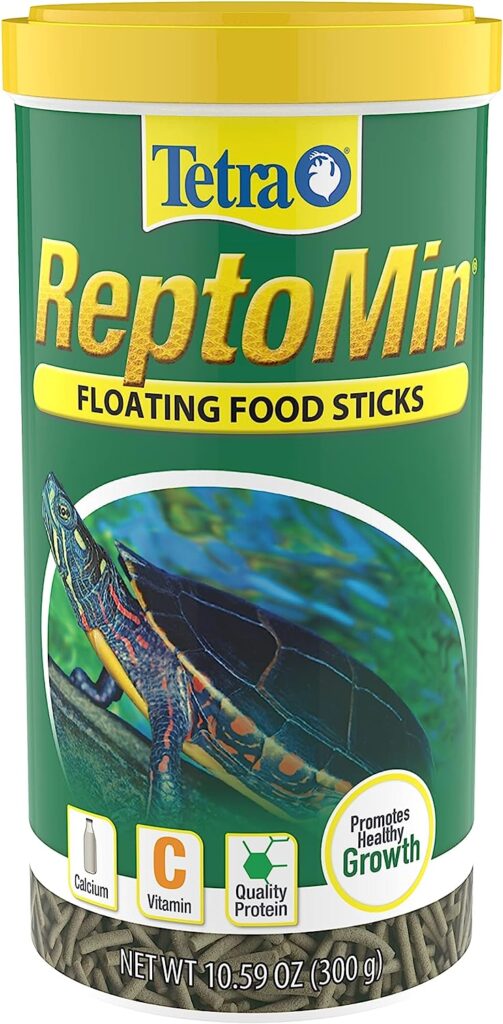
Features
- Brand: Tetra
- Flavor: Natural
- Age Range: All Life Stages
- Item Form: Stick
- Unit Count: 10.59 Ounce
- Customer Ratings: 4.8 out of 5 stars based on 13,882 ratings.
Pros
- Suitable for aquatic turtles, newts, and frogs.
- Well-established brand with high customer ratings.
- Formulated for all life stages.
Cons
- No significant cons reported
Tetra ReptoMin Floating Food Sticks are formulated for aquatic turtles, newts, and frogs of all life stages. With a 4.8 out of 5-star rating from over 13,000 customers, it attests to its popularity and effectiveness. The natural flavor and stick form cater to the feeding habits of these aquatic pets. With no significant reported cons, Tetra ReptoMin stands out as a trusted and widely accepted choice for aquatic reptile and amphibian nutrition.
7. Zoo Med Axolotl Food
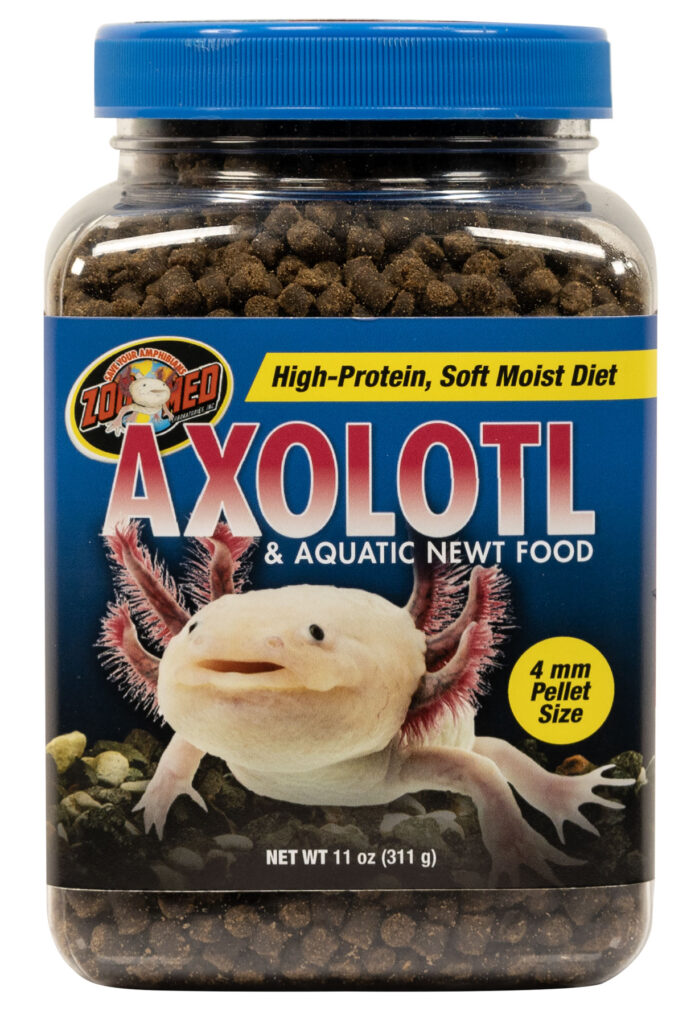
Features
- Description: Soft, moist pellets for axolotls, 4 mm pellet size.
- Sizes: 2.0 oz, 11.0 oz
- Feeding Instructions: Detailed instructions for juveniles and adults.
Pros
- Specifically designed for axolotls.
- High-protein content.
- Easy-to-follow feeding instructions.
- Guaranteed Analysis provided.
Cons
- No major cons reported
Zoo Med Axolotl Food is tailored for axolotls, offering soft, moist pellets in a 4 mm size suitable for larger juveniles and adults. The feeding instructions provide a clear guide for optimal usage, and the guaranteed analysis assures a high-protein diet. With no major reported cons and positive customer feedback, it stands as a specialized and reliable choice for axolotl nutrition.
8. Fluval Bug Bites Pellets
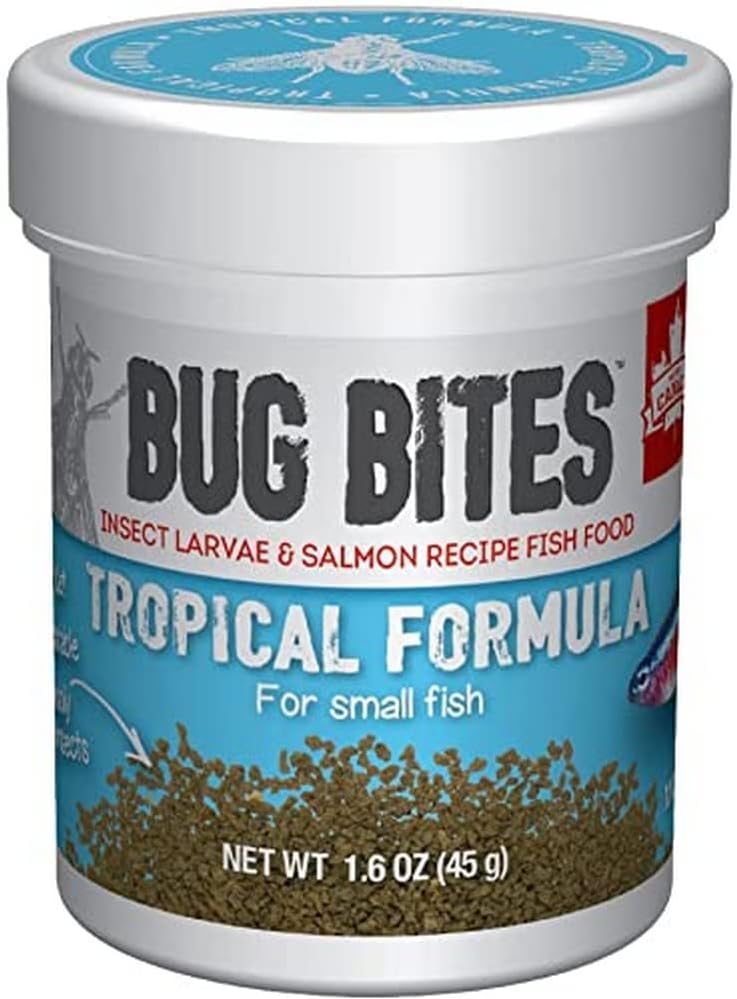
Features
- Brand: Fluval
- Style: Small Granules
- Top Ingredients: Dried Black Soldier Fly Larvae, Salmon, Concentrated Fish Protein, Green Peas, Potato
Pros
- Unique insect-based formulation.
- Sustainably harvested Black Soldier Fly Larvae.
- Positive customer reviews.
- Prepared in small batches for freshness.
Cons
- Potentially designed for small to medium-sized fish.
Fluval Bug Bites Pellets present a unique insect-based formulation for small to medium-sized fish. With a combination of Black Soldier Fly Larvae and other protein sources, it offers a well-rounded nutritional profile. The positive customer reviews and small-batch preparation for freshness enhance its appeal. Potential buyers should consider its availability, as it may vary, and its suitability for specific fish sizes.
9. Hikari Bio-Pure Freeze-Dried Daphnia
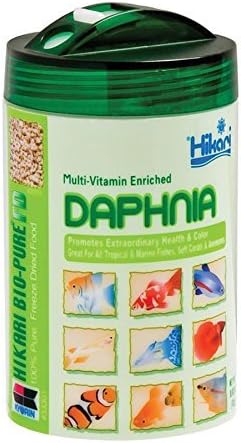
Features
- Brand: Hikari
- Item Form: Frozen
- Special Ingredients: All natural
- Package Information: Tub
- Freshness: 4.8, Value for money: 4.8, Flavor: 4.7
Pros
- Excellent daily diet or treat for freshwater and marine fishes.
- Freeze-dried for maximum freshness.
- Positive customer ratings.
Cons
- Limited information on specific ingredients.
Hikari Bio-Pure Freeze-Dried Daphnia provides a clean freeze-dried fish food option for various freshwater and marine species. With high ratings for freshness, value for money, and flavor, it is well-received by customers. The pharmaceutical freeze-drying techniques ensure maximum freshness, and its all-natural composition adds to its appeal. Availability may fluctuate, but its positive reception makes it a noteworthy option for fish owners.
10. Aqueon Bottom Feeder Tablets
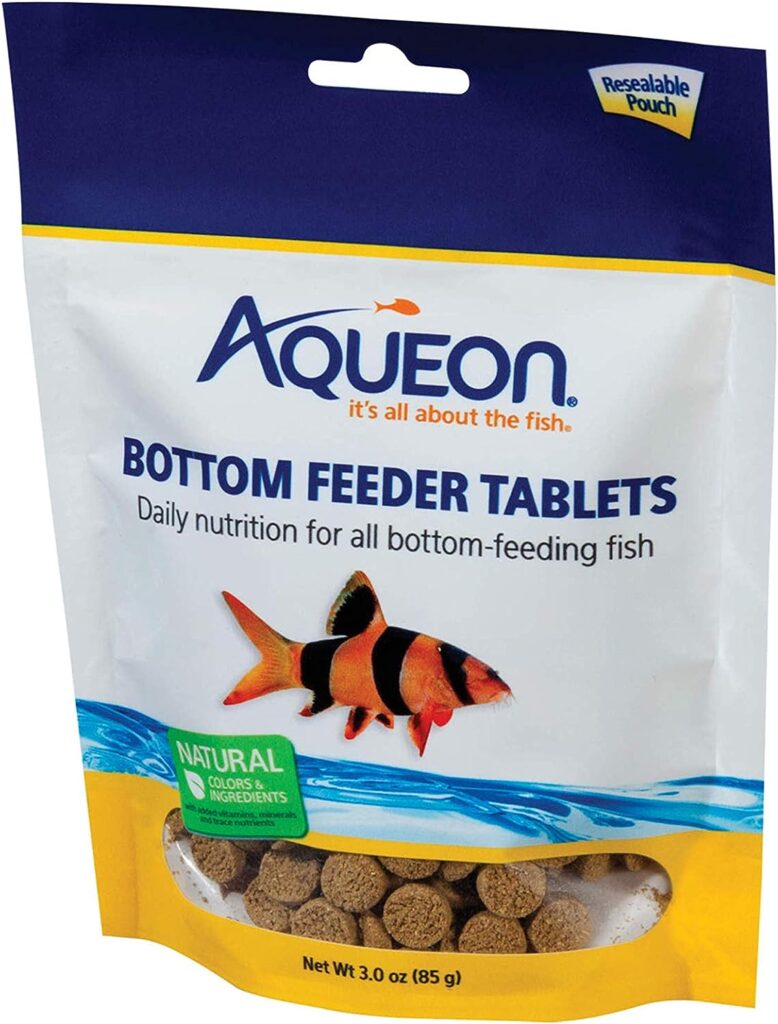
Features
- Brand: Aqueon
- Size: 3 Ounce (Pack of 1)
- Flavor: Fish Meal
- Item Form: Tablet
- Amazon’s Choice in Aquarium Fish Food by Aqueon
- Average Customer Rating: 4.5 out of 5 stars based on 1,825 ratings.
Pros
- Ideal for bottom-dwelling fish.
- Slow-sinking for bottom-feeders’ habits.
- Amazon’s Choice with high customer ratings.
Cons
- None
Aqueon Bottom Feeder Tablets, rated at 4.5 out of 5 stars, are designed for bottom-dwelling fish such as plecostomus, loaches, catfish, and shrimp. Recognized as Amazon’s Choice, these tablets offer a slow-sinking solution to accommodate the feeding habits of bottom-feeders. Despite being currently unavailable, its popularity and satisfaction guarantee, along with positive customer reviews, make it a sought-after choice for fish owners seeking immune support for their aquatic pets.
Things that you need to consider before buying food for your Axolotl
Before purchasing food for your axolotl, it’s crucial to consider several factors to ensure the health and well-being of your aquatic pet. Here are key considerations:
1. Nutritional Requirements:
- Axolotls are carnivorous amphibians, so their diet should consist mainly of high-quality, protein-rich foods.
- Look for foods specifically formulated for axolotls, ensuring they meet their nutritional needs at different life stages.
2. Protein Content:
- Opt for foods with an appropriate protein content (around 35-50%), as protein is vital for growth, development, and overall health.
3. Form of Food:
- Axolotls typically accept a variety of food forms, including pellets, frozen foods, and live foods. Consider the convenience and nutritional value of each form.
4. Balanced Diet:
- Choose a variety of foods to provide a balanced diet. Pellets, frozen bloodworms, and other live or frozen foods can be rotated to offer diverse nutrients.
5. Avoid Overfeeding:
- Axolotls are prone to obesity, which can lead to health issues. Feed them an amount they can consume within a few minutes to prevent overfeeding.
6. Nutrient Composition:
- Check the nutrient composition, including the levels of vitamins, minerals, and essential fatty acids. A well-rounded diet supports overall health.
7. Brand Reputation:
- Choose reputable brands known for producing quality axolotl food. Customer reviews and ratings can offer insights into the effectiveness of the product.
8. Avoid Artificial Additives:
- Minimize the use of artificial additives, preservatives, and color enhancers. Natural and wholesome ingredients are preferable.
9. Feeding Frequency:
- Axolotls have slower metabolisms, so they don’t require daily feeding. Adjust the feeding frequency based on their age and activity level.
10. Budget Considerations:
- Consider your budget while ensuring the selected food meets the nutritional needs of your axolotl. Balancing quality and cost is essential.
11. Availability:
- Ensure that the chosen food is readily available. Consistency in the axolotl’s diet is essential for their well-being.
12. Dietary Supplements:
- Assess whether additional supplements are necessary. Some axolotl foods may lack certain nutrients, and supplementation may be required.
13. Health of Axolotl:
- Consider any specific health conditions or dietary restrictions your axolotl may have. Consult with a vet if you have concerns about your pet’s health.
14. Responsiveness of Axolotl:
- Pay attention to your axolotl’s response to different foods. Some individuals may have preferences, and observing their behavior can help tailor their diet.
By carefully considering these factors, you can make informed choices when selecting food for your axolotl, promoting their health, longevity, and overall well-being. Regular monitoring and adjustments to their diet based on individual needs contribute to a thriving and happy axolotl.
FAQs
Q: What is the main component of a healthy axolotl diet?
A: A healthy axolotl diet primarily consists of high-quality, protein-rich foods.
Q: Can axolotls eat live food, and is it necessary for their diet?
A: Axolotls can eat live food, but it’s not strictly necessary. High-quality pellets and frozen foods can also provide essential nutrients.
Q: How often should I feed my axolotl?
A: Feed adult axolotls 2-3 times a week, adjusting the frequency based on their age, size, and activity level.
Q: Are there specific foods formulated for different axolotl life stages?
A: Yes, there are foods designed to meet the nutritional needs of axolotls at various life stages.
Q: Can axolotls be fed fish food designed for other aquatic animals?
A: It’s recommended to use food specifically formulated for axolotls to ensure their unique dietary requirements are met.
Q: How can I prevent overfeeding my axolotl?
A: Feed your axolotl an amount they can consume within a few minutes to avoid overfeeding and potential health issues.
Q: What should I consider when selecting frozen foods for my axolotl?
A: Choose frozen foods with high protein content, minimal additives, and a variety of nutrients for a balanced diet.
Q: Are there any dietary supplements necessary for axolotls?
A: Depending on the chosen food, some axolotls may benefit from calcium or vitamin supplements. Consult a vet for guidance.
Q: How do I know if my axolotl is responding well to its diet?
A: Monitor your axolotl’s behavior, growth, and overall health. A positive response includes healthy skin, steady growth, and alertness.
Q: Can I create a feeding schedule for my axolotl?
A: Yes, establishing a feeding schedule helps maintain consistency. Adjust the schedule based on your axolotl’s needs and preferences.
Conclusion
In conclusion, ensuring the well-being of your axolotl begins with providing a nutritionally rich and balanced diet. The 10 best foods for axolotls in 2023, as outlined in this guide, offer a spectrum of options catering to the unique dietary needs of these captivating aquatic creatures. From trusted brands like Hikari, Omega One, San Francisco Bay, Repashy, Tetra, Zoo Med, Fluval, and Aqueon, each product brings its own advantages, whether in the form of pellets, frozen treats, or specialized gel foods.
As conscientious axolotl keepers, selecting the right food involves understanding the amphibian’s nutritional requirements, age, and individual preferences. By incorporating these top-quality foods into your axolotl’s diet, you contribute to their growth, vitality, and overall health. Remember to observe feeding habits, adjust portions accordingly, and consult with a veterinarian for any specific dietary considerations. Elevating your axolotl’s diet not only ensures their physical well-being but also enhances the joy of keeping these remarkable creatures as cherished companions. Here’s to a vibrant and thriving aquatic life with your axolotls in 2023 and beyond.
With 3 years of devoted companionship alongside my aquatic friend, Bob, I’ve gained profound insights into the captivating world of fishkeeping. From understanding behavior to ensuring optimal health, my journey with Bob has enriched my expertise in all things aquatic.

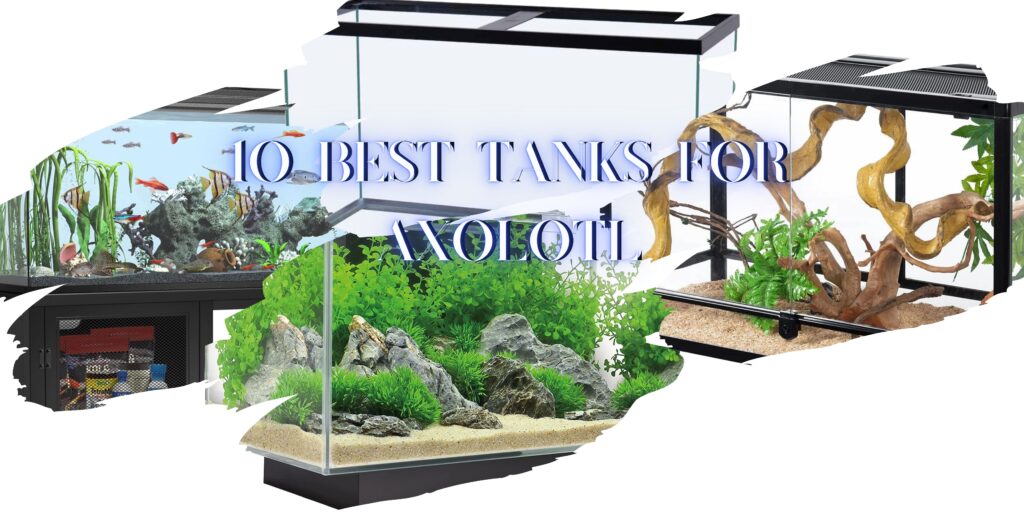
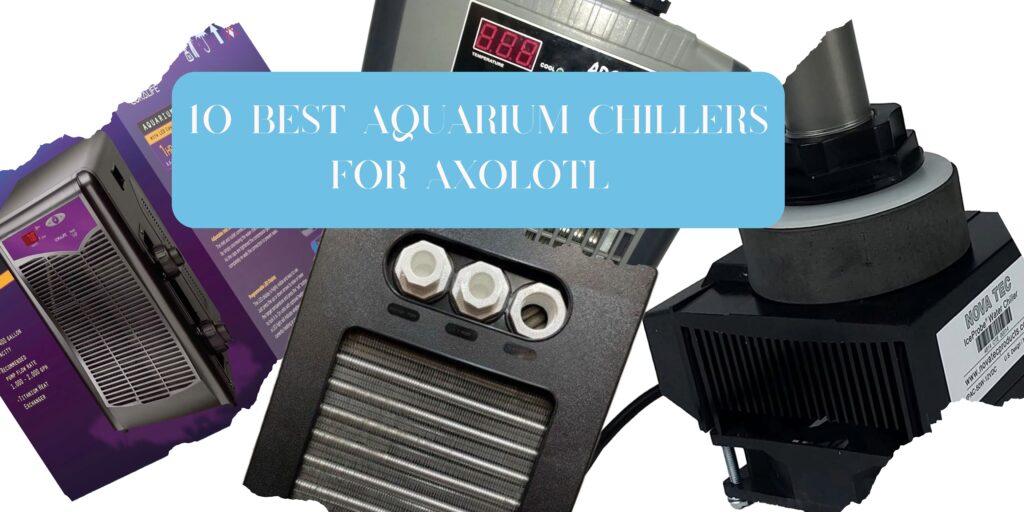
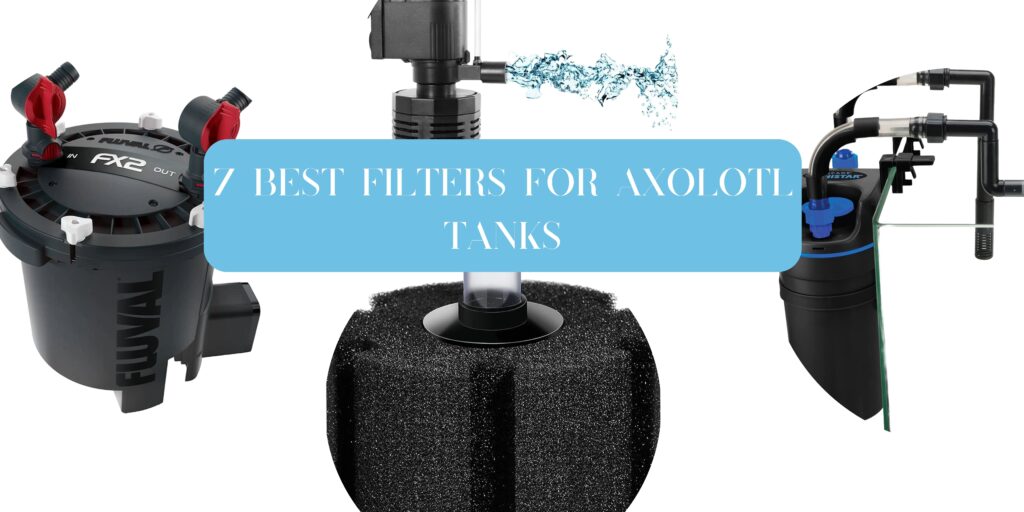
Pingback: Axolotl Health Issues: How to Treat Those Issues - Fish Hue
Pingback: Axolotl Poop Guide: Addressing Common Concerns - Fish Hue
Pingback: Axolotl Skin Care: A Complete Guide - Fish Hue
Pingback: Axolotl Sleeping: A Complete Guide - Fish Hue
Pingback: Axolotl Temperature: What's Best and How to Maintain - Fish Hue